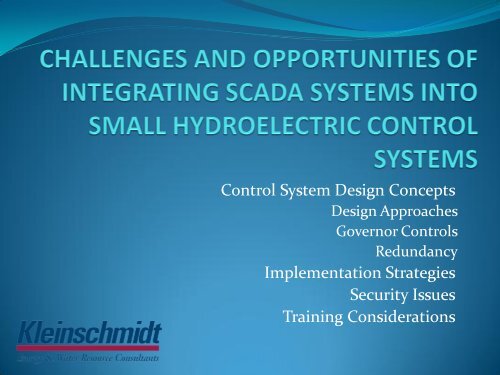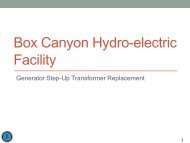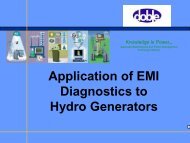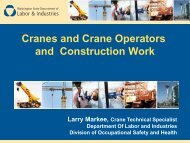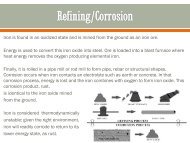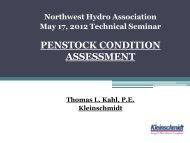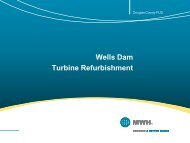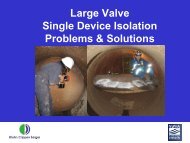Training Considerations
Small Hydro SCADA Systems
Small Hydro SCADA Systems
You also want an ePaper? Increase the reach of your titles
YUMPU automatically turns print PDFs into web optimized ePapers that Google loves.
Control System Design Concepts<br />
Design Approaches<br />
Governor Controls<br />
Redundancy<br />
Implementation Strategies<br />
Security Issues<br />
<strong>Training</strong> <strong>Considerations</strong>
What Is Small?<br />
• The definition of a small hydro project varies<br />
• Generating Capacity<br />
• Micro 0 – 100 kW<br />
• Mini 100 – 1000 kW<br />
• Small 1000 – 10,000 kW
Control System Design Concepts<br />
• Legacy Hardwired Systems<br />
• Remove Legacy Hardwired Control System and<br />
Replace with a new PLC/HMI Based Control System<br />
• Hybrid (combination of Legacy Hardwired and<br />
PLC/HMI based systems)<br />
• Remote Terminal Units (RTUs)<br />
• Which is Best for Small Hydro?
Legacy Hardwire Systems
Legacy Hardwired System<br />
• Advantages<br />
• Already in service<br />
• No upfront capital costs<br />
• Disadvantages<br />
• Higher long-term operating and maintenance costs<br />
• Little operations/maintenance data<br />
• Harder to troubleshooting<br />
• More equipment to calibrate and maintain<br />
• Modern Operations<br />
• Lower efficiencies<br />
• Lower reactivity to system upsets<br />
• Harder to operate/monitor remotely
Remove Legacy System<br />
Install PLC/HMI Based System
Remove Legacy System<br />
Install PLC Based System<br />
• Advantages<br />
• Less expensive to implement than Hybrid Systems<br />
• Less field work<br />
• Engineering is more straightforward<br />
• Less construction activities<br />
• Lower long-term operating and maintenance costs<br />
• Significant additional operations/maintenance data<br />
• Simplified troubleshooting and calibration activities<br />
• Modern operations<br />
• Additional efficiency<br />
• Significantly increases remote operation/monitoring
Remove Legacy System<br />
Install PLC Based System<br />
• Disadvantage<br />
• The biggest disadvantage is the loss of a hardwired<br />
“back-up” control system. If the PLC/HMI system<br />
malfunctions then the unit(s) is shutdown until the<br />
control system is repaired.<br />
• The loss of the “back-up” control system can be<br />
somewhat mitigated with redundancy design in the<br />
PLC/HMI system. However, this will increase cost and<br />
off-set any savings gained from not implementing a<br />
Hybrid system.
Maintain Legacy System<br />
Install PLC/HMI Based System (Hybrid)
Hybrid System<br />
• Advantages<br />
• The biggest advantage with integrating the PLC/HMI based<br />
system with the Legacy system is the redundancy. If one<br />
system is down, the other will still function<br />
• Improved long-term operating and maintenance costs of<br />
Legacy systems<br />
• Significant additional operations/maintenance data<br />
• Simplified troubleshooting and calibration activities<br />
• Modern operations<br />
• Additional efficiency<br />
• Significantly increases remote operation/monitoring
Hybrid System<br />
• Disadvantages<br />
• Most expensive to implement<br />
• Significant field work<br />
• Engineering is more complicated<br />
• Increased construction activities<br />
• Requires legacy equipment to be calibrated and<br />
maintained
Remote Terminal Unit (RTU)
RTU<br />
• Advantages<br />
• Low initial cost<br />
• Remote monitoring and control (limited)<br />
• Disadvantages<br />
• Higher long-term operating and maintenance costs<br />
• Same as Legacy System, plus new RTU<br />
• Modern Operations<br />
• Same as Legacy System, except for limited remote monitoring<br />
and control.
Control System Design Concepts<br />
SYSTEM<br />
INITIAL COST<br />
OPERATING &<br />
MAINTENANCE COST<br />
UNIT & PLANT<br />
CONTROLLABILITY<br />
Legacy Hardwired N/A High Low<br />
PLC & HMI (only) Medium Low Medium<br />
Hybrid System High Medium High<br />
RTU Low High Low<br />
Small Hydro with Legacy Hardwired systems often benefit most from the<br />
RTU option due to the low initial cost and minimal gains in O&M and<br />
controllability.<br />
New Small Hydro systems often benefit most from the PLC & HMI (only)<br />
option due to the savings from hardwired controls (distributed I/O) and<br />
gains in O&M and controllability.
Design Approaches<br />
• Distributive: PLC I/O throughout facility with<br />
distributed racks networked to the processor<br />
• Centralized: PLC I/O hardwired to on common place<br />
where the PLC I/O racks and the processor are<br />
located
Distributive Design<br />
FACILITY<br />
CONTROL ROOM<br />
HARDWIRE<br />
NETWORK<br />
PLC PROCESSOR RACK<br />
PLC REMOTE RACK<br />
PLC REMOTE RACK<br />
PLC REMOTE RACK
Centralized Design<br />
FACILITY<br />
CONTROL ROOM<br />
PLC PROCESSOR RACK<br />
HARDWIRE<br />
NETWORK<br />
PLC REMOTE RACK<br />
PLC REMOTE RACK<br />
PLC REMOTE RACK
Design Approaches<br />
SYSTEM INSTALLATION COST SECURITY MAINTENANCE TROUBLESHOOTING<br />
Distributive Medium Low<br />
Harder (Distributed over<br />
large area)<br />
Easier (connection are local to<br />
devices)<br />
Centralized High High<br />
Easier (Local connections<br />
and controls equipment)<br />
Harder (connections are not local to<br />
devices)
Governor Controls<br />
• Fly Ball<br />
• Digital Governor<br />
• Gate Positioner (PLC)
Governor Controls<br />
SYSTEM INSTALLATION COST RESPONSE TIME ISOCHRONOUS CONTROL<br />
Fly Ball N/A Medium Medium<br />
Digital Governor High High High<br />
Gate Positioner Medium Medium Medium<br />
Small Hydro with Legacy Fly Ball governors often benefit from a retrofit to a<br />
Gate Positioner. New Small Hydro often benefits from a Gate Positioner, unless<br />
Isochronous Control is very important and dynamic in which a Digital Governor<br />
should be used.
Redundancy<br />
• Power Supply Redundancy<br />
• PLC Redundancy (option A): Redundant I/O cards (in a<br />
single rack), processors (in a single rack), and power<br />
supplies.<br />
• PLC Redundancy (option B): Redundant I/O racks, processor<br />
racks, and power supplies.<br />
• PLC Redundancy (option C): Redundant I/O racks,<br />
processor racks, networking equipment, networking cables,<br />
and power supplies.<br />
• Full Redundancy<br />
• Small Hydro often benefits most from Power Supply<br />
Redundancy only.
Security Issues<br />
• Physical Security<br />
• Physical security of a previously occupied station (e.g., remote cameras,<br />
access controls)<br />
• Locked six-walled enclosure for networking equipment, with access<br />
controls<br />
• Cyber Security<br />
• Use of firewalls, threat managers, etc.<br />
• Choice of network protocols<br />
• Choice of media<br />
• Hardening of PCs, servers, switches, routers, etc.<br />
• NERC-CIP provides rules, regulations, and guidance<br />
• Small Hydro can often be classified as non-critical assets and can<br />
there keep the security requirements low. If the station is classified<br />
as a black start asset and used for bootstrapping the grid, however, it<br />
may be classified higher requirements more strict security.
<strong>Training</strong> <strong>Considerations</strong><br />
• Modern automation system are fundamentally different<br />
from legacy hardwired systems and require a different set<br />
of skills to maintain<br />
• Computer savvy<br />
• Program applications knowledge<br />
• Networking knowledge<br />
• Understanding of I/O hardware and configurations
<strong>Training</strong> <strong>Considerations</strong><br />
• Operating modern automations, via and HMI, is also<br />
fundamentally different and requires additional training<br />
• Computer savvy<br />
• HMI menus, paging, and graphics<br />
• Trending capabilities and configurations<br />
• Alarm classes and alarm management<br />
• How legacy systems and automation systems<br />
interact (in hybrid systems)
Summary<br />
• Each stakeholder—owners, engineers,<br />
operators, and maintenance staff—should be<br />
fully engaged during all stages of the design,<br />
construction, and start-up process of a hydro<br />
unit or hydro station automation upgrade.<br />
• Discussion between all stakeholders should<br />
included Design Concepts, Design Approaches,<br />
Implementation Strategies, Security Issues,<br />
and <strong>Training</strong> <strong>Considerations</strong>


